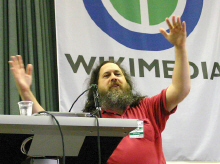What future faces FOSS?


Politically they are. In fact they are not.
Free software is Richard Stallman, with his beard like that of a Civil War veteran, possibly Confederate, and his messianic belief that freedom isn't free, that if you're to be given something you owe something in return.
Open Source is Jonathan Schwartz, with his hair pulled back, his elegant business suit, insisting on a business model and re-scaling Sun Microsystems to the limit of that model.
Most companies in the free and the open source spaces combine giveaways of software, giveaways of source code, and a variety of working business models into a coherent whole that can work in many different niches.
How different? Well consider Adaptive Planning. Its software sits at the top of a very large stack of enterprise products. Its current universe of potential users is very, very small. Competitors like Cognos and Business Objects charge big bucks for the services of this software. Yet AP gives away one version of its product, licenses another under the GPL, and expects to profit from selling “software as a service.”
Now consider Grisoft. They offer one of the most basic, general-purpose applications around, anti-virus protection. They have many different versions of this software, sold for many types of users. Yet because of their giveaway they are growing fast, against big-time competitors like McAfee and Symantec. I'm currently running a free version.
In the last year both enterprises and individuals have been moving toward software they can get for nothing. On the enterprise side projects like PostgreSQL have been scaling to enterprise size, Apache is a world-beater, and Linux itself just keeps getting better. On the user side I'm running Firefox, Open Office and AVG, a $700 value, mine absolutely free.
Critics charge that this can't continue, that the Gods of profit must be appeased, that FOSS only replaces existing solutions and kills software industry jobs. But these are political arguments. In the real world of business, FOSS continues moving from strength-to-strength, and the two movements – free and open source – seem to be moving in lockstep.
I'll be looking at this in more detail all week. Stay tuned for the next chapter, The Open Source Incline.
For the next week I'm going to offer a feature, in five parts, describing the current state of the Free and Open Source movements and where they might be headed. Hope you enjoy it.